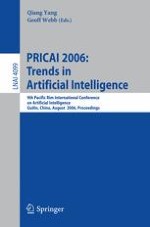2006 | Buch
PRICAI 2006: Trends in Artificial Intelligence
9th Pacific Rim International Conference on Artificial Intelligence Guilin, China, August 7-11, 2006 Proceedings
herausgegeben von: Qiang Yang, Geoff Webb
Verlag: Springer Berlin Heidelberg
Buchreihe : Lecture Notes in Computer Science
